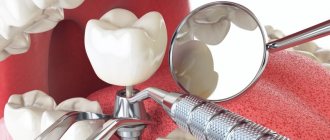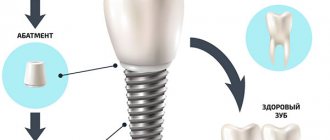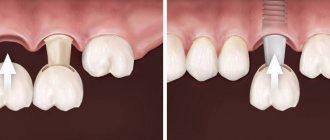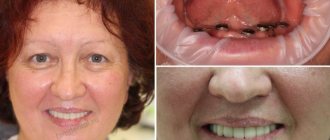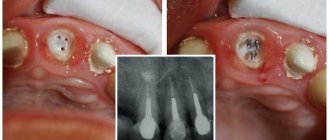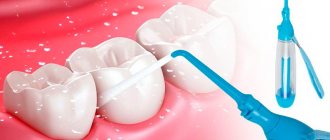Dental implantation is the most predictable treatment method for replacing lost teeth and restoring their functions and appearance. There is no need to damage or grind down adjacent healthy teeth.
Dental implantation is a safe solution for patients of any age and for any situation . By choosing implants, you choose safety and quality for life. You will have a beautiful smile and will be able to enjoy food again.
In this section you will find answers to all your questions about treatment, implant care and much more.
Recently, people have begun to take greater care of their health and pay increased attention to aesthetics. Dental implantation in Vladimir has become an integral part of treatment . now widely known as a safe and effective way to restore missing teeth.
If you are seriously interested in dental implantation, then below you will find answers to most of your questions:
- What is a dental implant?
- How is dental implant installation performed?
- What is the cost of implants?
- What materials are implants made from?
A dental implant is not a prosthesis, but the return of a smile!
The history of implants in general and dental implants in particular began with the Swedish scientist Ingvar Brånemark. He found out that titanium – a metal like that, if anyone doesn’t know – fuses well with bone tissue and does not cause an allergic reaction. Since then, titanium has been actively used in medicine.
A dental implant is essentially a titanium screw. It is screwed into the jawbone, and when it takes root, a crown is placed on top.
By the way: in terms of aesthetic qualities and functionality, implanted teeth are not inferior to real ones, and sometimes even surpass them. They serve for decades; many manufacturers give a lifetime warranty on their implants.
Why get implants? You will find the answer to this question yourself when, after installation, you stop hiding gaps in your teeth from your friends, picking out leftover food from them and struggling with removable dentures.
Important! When choosing a clinic, be sure to check for a license specifically for surgical activities; it must be posted on the information stand or on the clinic’s website, otherwise you will receive medical care of dubious quality and put your health at risk.
Dental implantation in Yaroslavl
A visit to the dentist is one of the problems that any person faces: either due to his reckless dental lifestyle, or due to the transience of time, when you are already familiar with such a thing as a midlife crisis. I am very meticulous in choosing a doctor; probably only young mothers who are waiting to meet their first child are more meticulous. And my choice fell on the Dentist (I’m not afraid to write this word with a capital letter) - Kristina Viktorovna Skopich. At first, when I entered the dental office, I was scared off by the young appearance of the doctor, because we all understand that the more wrinkles on the face, like the growth rings of a tree, the more time a person had to spend improving and honing his dental skills over the years, but here it was quite the opposite, A very young and beautiful girl appeared before the house. As a person who is a little knowledgeable and cares about his health, I can easily answer such simple questions and easily draw a connection that is understandable to every first-year medical student: ROCS or Sensodyne, dentinal tubules and tooth sensitivity. As soon as I found myself in the chair, before starting the examination of the oral cavity, Kristina Viktorovna talked to me and listened to my complaints, not just preparing the workplace and casually, but with sincerity in her voice and interest in her eyes. I complained about the blackness that had formed, which was starting to bother me and my wallet. She said that the tooth required medical intervention and I decided that I needed to trust the opinion of the Expert. She gave the injection very carefully and discreetly, and I am terribly afraid of injections, especially when your gums are very sensitive. She did it so delicately and easily, simply asking me to inhale, and I didn’t notice how my upper jaw had already lost sensitivity. Here I would like to draw your attention to how a dentist works. She roughly grabs your face, all her movements are smooth and predictable, and of course, any toothache is easier to bear when you see such a charming smile, and not an overworked and angry doctor. Last time, my filled hole was a different enamel color than my natural teeth color. Kristina Viktorovna spent a lot of time on this and chose everything exactly in tone, now it will become my secret, which no one from my surrounding work colleagues will guess about.
To summarize, I will say the following: 1) Don't judge a book by its cover, gray hair is not an indicator of skill. 2) Kristina Viktorovna - Lefty of our time. 3) I will definitely have my teeth treated by you “Pla-dent” and will recommend it to all my friends.
ps Thank you for your responsible approach in choosing Specialists, because people are ready to travel from remote corners of our city, just for the sake of the atmosphere and trust that you create. I wish you success and courage in all your endeavors. With all respect, Andrew.
Installation of a dental implant: once and for life!
Implantation is a safe and painless procedure. There is no need to grind down adjacent teeth; the operation is performed under local anesthesia. Consultation with your doctor is required.
By the way : consultation at the Style Dent clinic is absolutely free . You can make an appointment by calling 8 (4922) 52-55-56 or following this link .
Dental implantation is carried out in three stages:
- Installation of an implant, the same screw in the jaw bone. The procedure itself takes about half an hour. But after that it takes from 3 to 6 months for the implant to osseointegrate (“take root”). At the request of the patient, a temporary structure is installed in place of the missing tooth during this time. Eating as usual.
- When the implant “takes root”, a gum former is installed on it. From the name it is clear that this is the stage of preparing soft tissues for the installation of the last part - the crown. The former remains in the gum for about two weeks.
- Tasty for the third: the process of tooth implantation is completed with the installation of a crown. The crown can be made of different materials - solid, metal-ceramic, ceramic, made of zirconium dioxide. A removable or non-removable design is available. In this matter, everything is determined by the patient’s preferences.
Thus, the operation to install the implant and its subsequent osseointegration takes from 3 to 6 months. Therefore, if there is a need to install several implants, it is better to do everything in one visit. It's easier psychologically and saves a lot of time.
By the way: the described technique has proven itself well and is classic. Also, specialists at the Style Dent clinic successfully practice the one-step installation of an implant in place of a problematic tooth immediately after its removal.
But there are other ways. For example: implantation with a single-stage load. The main difference between this method is that the implant is installed immediately with a temporary crown. It changes to permanent after 4-5 months, when the implant osseointegrates (“takes root”).
The technique is optimal for patients who are short of time, although it is not applicable in all cases.
By placing an implant, you free yourself from many problems. After all, it is not susceptible to caries, does not darken and does not have hypersensitivity.
Metal-free ceramics on a zirconium dioxide framework
Dental prosthesis using high-tech ceramics with excellent mechanical properties, good biological compatibility for humans and excellent color refraction.
A new, advanced prosthetic method has become available in our dental office - metal-free ceramics on a zirconium dioxide frame!
Advantages:
- Excellent biocompatibility -
zirconium oxide is far superior to any alloys, including precious ones. - Super strength - provided by a zirconium frame, the service life of the crown is significantly increased.
- The zirconium frame does not deform.
- The thickness of the zirconium dioxide frame is 0.4 mm!!!. The tooth is ground down for a crown - minimally, gently!
- Zirconium crowns are very light.
- Ensures high precision
in the manufacture of crowns!
Dental orthopedic doctors advise using the latest super-strong development for prosthetics of your teeth, which is superior in biocompatibility and strength to metal-ceramics and alloys made of precious metals - a crown based on zirconium dioxide.
Advantages of dental implants
Implants are very comfortable and provide an aesthetic and functional result that is as close as possible to natural teeth.
Functionality. Dental implants restore the efficiency of chewing function, provide stable support, and also look and feel like natural teeth.
Preservation of natural teeth . Installation of dental implants with crowns in those areas where, adjacent to natural healthy teeth, one or more teeth are missing (“included defects”), allows you to avoid grinding down healthy teeth and root canal treatment (depulping) for a bridge.
Aesthetics. Dental implants feel and look almost identical to healthy teeth. They enable patients to smile, laugh, chew food well, and communicate with comfort and confidence again.
Metal-ceramics (metal-ceramic dental crowns)
This type of dental prosthetics is a combination of metal and ceramic crown elements.
Metal-ceramic crowns consist of a durable metal frame coated with a layer of ceramic.
Advantages:
- an artificial tooth does not differ from a real tooth in color and transparency;
- allows you to chew food well;
- hygiene - microbial plaque settles on metal ceramics several times less than on living teeth or metal (this is especially important for patients with periodontitis!);
- durability - today this is the most durable design in dentistry;
- does not cause redness, swelling or bleeding of the gums.
Surgical stage
- Implant installation
- Installation of a cover screw on the implant
- Stitching
- After 10-14 days, the sutures are removed
Next, the implant must be kept without load for 3-4 months. In case of code, bone grafting was performed at the same time, the healing time will be increased.
- After 3-4 months, the plug screw on the implant is removed and a gum former is installed in its place. The former provides contouring of the soft tissues around the implant by tightly fitting the gums.
- suturing
Implant for removable denture
Prosthetics is a very important and serious procedure. Consultation with a Dentalux dental
will help you decide on the type and method of installation of the prosthesis.
Removable prosthetics on implants
used when most of the teeth are lost, including all dental units of the oral cavity (adentitis), and in the absence of the opportunity to place more than 4 implants. Then clasp, nylon or acrylic removable structures are used.
Contraindications to implantation:
HIV or AIDS, tuberculosis, diabetes, circulatory pathologies; pregnancy and breastfeeding; dental diseases; cysts, granulomas. All this can provoke implant rejection.
What is an implant?
This is, in fact, an artificial tooth root on which an artificial tooth or several teeth are attached, combined into a structure. The main quality of an implant, therefore, is the ability to be implanted into bone tissue in order to subsequently fuse with it into a single whole and allow you to forget about the implant and not feel it at all.
Implants for removable dentures made from titanium metals are preferred because they have the highest degree of biological compatibility: oral tissues accept them normally, do not try to reject them, and do not cause discomfort.
Orthopedic stage
- 2-3 weeks after installation of the gum former. The former is removed and an impression coping is installed in its place.
- Next, impressions are taken and the gum former is reinstalled.
- After a few days, a temporary composite crown is installed in place of the gum former so that the load on the implant occurs gradually and the formation of the mucous membrane for the permanent crown occurs.
- The patient walks with a temporary crown for 2 to 6 months (it is installed for both aesthetics and functional load)
- After this period, a transfer is installed in place of the temporary crown and an impression is taken
- Next, the impression is sent to one of the largest dental laboratories in Russia in St. Petersburg, where an individual abutment is made, which is precisely calculated individually for each patient
- At the end, an individual abutment is installed, which is fixed with new screws (to avoid their damage (metal fatigue, thread failure) and a permanent crown is installed on top of the abutment.
We precisely follow surgical and orthopedic protocols to ensure reliable clinical results and long-term functional prognosis.
Advantages of all on 4 dental implantation - affordable starting price
- Bone atrophy occurs according to certain laws. The earlier a person loses teeth, the more pronounced atrophic processes are. Most often, people lose their chewing teeth first, since their need is not always obvious to many and treating teeth that are not visible when smiling seems like a waste of time, nerves and money. But not only this contributes to the loss of teeth in the lateral regions. Despite the continuous progress in the field of endodontics, treatment of dental canals is still a difficult task, since in a large percentage of cases there is anatomical atypia in their structure, significant bending of the canals, and obliteration (narrowness). Complete successful filling is most often successful in young subjects, provided that the tooth is depulped in the stage of deep caries and the dental pulp is not infected, and the canals themselves are not curved. It is in such situations that modern endodontic handpieces and endomotors with pro-taper and profile systems show excellent results. However, even under these conditions and this equipment, modern endodontists are not always able to achieve high-quality filling of the entire delta and the treatment of the canals is accompanied by further complications, expanding the scope of work for implantologists.
- Over time, without the support of the lost chewing teeth, the front teeth are also destroyed. However, the bone of the alveolar process in the frontal areas retains the necessary volume, which allows the insertion of supports without bone augmentation and with a high degree of reliability.
- Implantation in the lateral jaws is very complicated by the presence of anatomical structures - the mandibular canal below and the maxillary sinus above. In the anterior region, the installation of implants is not associated with the risk of trauma to these structures. In the area of the canines and premolars there are buttresses, bone formations with a high degree of resistance to atrophy.
- Thus, the implantation of the anterior row is performed in the frontal part of the jaws with a vertical installation with a slight inclination, and lateral implantation is performed at an angle of 45 degrees. With this technique, a greater distance is created between the implants and the load is distributed evenly. This allows you to successfully perform the operation and achieve high primary stabilization of artificial supports.
- This makes it possible to carry out aesthetic and functional rehabilitation of the frontal part of the jaw in the shortest possible time, returning the person to the aesthetic norm and the ability to chew food, while simultaneously performing osteoplasty surgery in the distal parts where the chewing teeth were located.
- In the near future, within a period of six months to a year, 2 additional implants should be installed in the area with the increased bone and prosthetics with bridges should be performed.
Types of prostheses for all-on-four implant technology
When using 4-support prosthetics, dentists often offer removable dentures of various designs. Higher-quality fixed bridges for new teeth are quite possible, but their installation is possible only if the implants are of sufficient length and have high primary stability.
- In many dental clinics they are usually called conditionally removable. They are attached to the implants with special screws. Thus, while wearing the prosthesis, the patient cannot independently remove the prosthetic structure. Control and prevention of the appearance of plaque on a conditionally removable structure is carried out two or three times a year in the dentist’s office. Most patients who use conditionally removable dentures are satisfied with the result, since at least one problem is completely solved - restoring the beauty of the smile. Most often, chewing function and diction are completely restored. however, the strength of screw-retained acrylic prostheses is insufficient and they are prone to breakage. Therefore, one should strive for full prosthetics with bridges supported by at least 6 implants.
- Having 4 stable implants, it is possible to produce a partially removable denture with various fixation systems. A removable denture will prevent excessive stress on the new artificial supports and restore the beauty of your smile. Powerful, solid clasps are not entirely desirable; clasps made of high-strength extruded plastic are preferable. The removable denture itself must be made of high-strength plastic with silicone additives, since balancing of removable dentures is unacceptable. Typically, a conditionally removable denture successfully performs its function within a period of up to a year. Further, due to the natural process of atrophy, its fixation simultaneously on the mucous membrane and on the implants is disrupted. The prosthesis loses contact with the mucous membrane and the supporting implants begin to be overloaded and become loose.
- Instead of crowns, a fixing abutment of the matrix-matrix type can be used. In this case, the abutment fixed to the implant fits into a congruent (geometrically compatible) male welded into the removable denture. The fixing elements or attachments themselves, most often push-button or magnetic fasteners, are offered by the manufacturers of implantation systems themselves and are fully compatible and adapted to the implants being inserted. All these fixation systems certainly improve the quality of prosthetics,
- I would especially like to mention the beam clamps. With this technology, the installed implants are connected to each other with a metal arc-shaped plate, which acts as an attachment and fixator, and a removable prosthesis with a male in the thickness of the prosthesis is made on it.
- When using beam fixation, the implants are additionally splinted together with a beam, and the fastening of the removable denture is durable, reliable and very hygienic. At the same time, with the beam fixation system, you can take even the hardest foods. Perhaps this is the most reliable system, but at the same time it is the most expensive.
How to prepare the patient and his oral cavity for the installation of four all-on-4 supports
Preparation for an inexpensive all-on-four implantation operation does not have any special features. Full anesthesia is required. If there are roots of decayed teeth in the oral cavity or there are diseased teeth, they are removed or treated. Typically, root removal is performed during implantation surgery, and an implant is inserted into the sockets of the removed roots. Study of the patient’s general condition at the preparatory stage - blood tests, medical history and x-ray diagnostics, computed tomography is desirable. If the patient is healthy based on the results of the study, consent is obtained for the operative surgical procedure. However, if systemic diseases are detected, as well as blood diseases, or a weakened immune system, then the implantation operation must be postponed until therapy for the identified diseases is completed. It should be noted that the patient undoubtedly benefits from the point of view of price and time with all-on-4 prosthetics. However, implantologists themselves prefer to carry out prosthetics on at least six implants.
It is difficult for a person who has not received a specialized medical education and does not have surgical experience to discern the difference between the number of supports and the durability of the final result of dental prosthetics. An experienced implantologist prefers to get long-term results the first time and for a long time, and with six implants the reliability is certainly higher. In addition, bridge-like fixed denture structures can be used on six implants, and they are much more functional and beautiful. It is difficult for the patient to understand all these subtleties, but it is worth taking their word for it (and then, of course, double-checking) that a bridge prosthesis causes much less inconvenience and in all respects corresponds to their real teeth. Another thing is that it is not always possible to install all 6 or 8 supports at once; in the distant parts of the jaw there is not enough bone height, and I would like to smile as soon as possible. It is in these cases that 4-support prosthetic systems help, they reduce rehabilitation time and improve the quality of life
Today dentistry identifies two technologies: all on 4 (all on 4) and all on 6 (all on 6)
Let's look at their advantages and disadvantages. The main sign of the use of these technologies is the absence of more teeth or complete edentia. For both technologies, the implant is immediately placed in the socket of the tooth to be removed. Both options help quickly restore chewing function quickly and inexpensively, and in most cases does not require growing new bone. The denture is secured with screws and, if necessary, can be removed for routine inspection and cleaning. For treatment, it is advisable to use computer modeling and implant installation templates.
This prevents medical error and ensures the accuracy of the implant placement operation. Prosthetics are possible in the presence of significant bone tissue atrophy. The main difference between six supports and 4 supports is the possibility of higher quality fixed prosthetics with high reliability. A conventionally removable denture with 4 supports has the main drawback - the need for constant monitoring by the dentist. Visits to dentists are rarely free; most often you have to pay for the pleasure of being in a dental chair and receiving some manipulations in your mouth. Thus, the money saved on two implants will gradually be spent on additional services for the care of dentures on four supports.
Peculiarities
The implants are placed under the gum into the jaw bone and wait for them to fuse with the bone. Sometimes, immediately after installation, abutments and a temporary prosthesis can be placed on the implants until healing is achieved. In most cases, it is possible to reline the existing removable denture so that it does not interfere with the healing of the implants.
New teeth are securely attached to the bone and, by transferring the load to it, they prevent atrophy of the jaw bone tissue. Such a prosthesis can be easily removed for independent oral hygiene.
If all teeth in the lower jaw are missing, it is recommended to install five implants to ensure reliable support for the prosthesis. If all teeth in the upper jaw are missing, it is recommended to install six or more implants to ensure reliable support for the prosthesis.
pros | Minuses |
|
|
Features of augmentation mammoplasty
The purpose of the operation: installation of an endoprosthesis (implant) in the thoracic area - a capsule with a gel-like filler (most often silicone). According to patient reviews, breast lifting and enlarging implants are so natural that they are not detectable visually or to the touch. At the same time, they do not damage the tissue of the mammary glands, which allows the woman to breastfeed her children in the future. The beautiful shape and size of the mammary glands obtained as a result of plastic surgery are preserved for life.
Types of implants
The endoprostheses used differ in design and size, which allows you to obtain a mammary gland of the desired shape and volume. For endoscopic breast augmentation, the CONSTANTA Clinic uses two types of implants :
- round , allowing you to significantly increase the volume and make the breasts more voluminous;
- anatomical (cone-shaped) , used for a slight increase in the bust with tightening of age-related sagging skin.
The appropriate type of prosthesis, its shape and volume are selected individually, taking into account the wishes of the patient, the anatomical features of the physique, and the condition of the mammary gland tissue. Breast implants today are produced by dozens of companies around the world. The most popular products are from European and American manufacturers. At the CONSTANTA Clinic, patients are offered implants from leading world brands :
- Polytech, Germany;
- Mentor, USA;
- Allergan/McGhan, USA;
- SILIMED, Brazil;
- Arion, France;
- Motiva (Costa Rica).
Choosing an implant placement site
The area of placement of the endoprosthesis and the method of access are determined individually for each patient in consultation with the doctor. A number of factors are taken into account:
- initial bust volume;
- the size of the implant itself;
- location of the mammary glands on the chest (high or low);
- the degree of development of the pectoral muscles and the condition of the skin of the chest.
Depending on this, the plastic surgeon at our Clinic can offer several ways to install endoprostheses :
- under the mammary gland;
- under the pectoralis major muscle;
- under the fascia of the pectoral muscle.
The chosen implantation method affects the location of the suture, which may be located:
- under the breast in the fold between the mammary gland and the rib cage;
- in the armpit;
- along the edge of the nipple areola.
Methods for increasing breast volume
In their work, plastic surgeons at our Clinic use the following breast augmentation methods:
- Lipofilling . Breast augmentation without incisions and long rehabilitation using the patient’s own fat tissue taken from other areas of the body (hips or abdomen), which easily take root. Lipofilling allows you to increase your bust by 1-1.5 sizes in a low-traumatic way, correcting shape imperfections.
- Augmentation mammoplasty . Endoprosthetics using breast implants, which allows you to give the mammary glands any volume that will remain forever. In most cases, for breast enlargement, plastic surgeons at our Clinic use the most effective method of endoprosthetics today, which enlarges the breast by several sizes at once.
